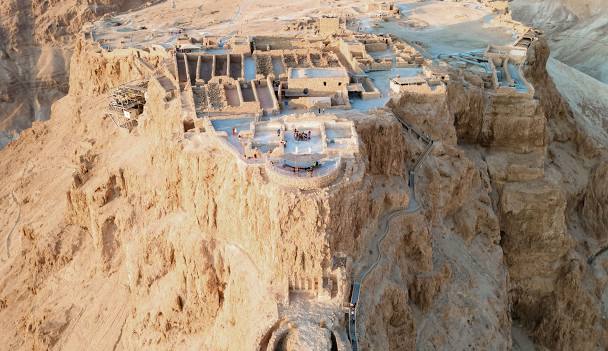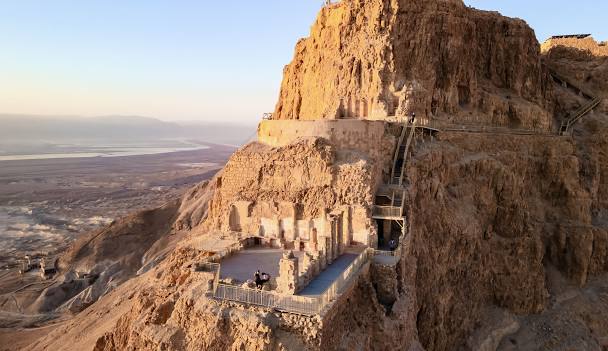Masada is one of Israel’s most significant and awe-inspiring landmarks, renowned for both its breathtaking beauty and its profound historical importance. Perched atop a plateau overlooking the Dead Sea, this ancient fortress holds stories of resilience, military strategy, and defiance. Masada’s captivating history and stunning landscape draw thousands of visitors each year, making it a must-visit destination for those exploring Israel’s rich heritage. Follow archeology.dulichvn.net to discover many hidden mysteries that have yet to be discovered.

The Historical Significance of Masada
Masada: A Symbol of Jewish Resistance
Masada’s historical importance is rooted in its role as a symbol of Jewish resistance during the First Jewish-Roman War. In 73 CE, a group of Jewish zealots, led by Eleazar ben Ya’ir, made their last stand against the Roman Empire at Masada. The fortress, which was once a palace built by King Herod, became a sanctuary for the Jewish rebels. Despite the Romans’ efforts to breach its walls, the defenders held out for months, ultimately choosing death over surrender. This act of defiance has made Masada a symbol of Jewish strength and the fight for freedom.
Masada’s Construction by King Herod
Masada was originally constructed by King Herod the Great in the 1st century BCE as a fortified palace and retreat. Herod, known for his ambitious architectural projects, chose the site for its natural defenses, perched high above the desert floor. The complex includes sophisticated infrastructure, including water cisterns, a palace, and a synagogue. Herod’s vision was to create an imposing fortress capable of withstanding a siege, and Masada’s strategic location made it an almost impenetrable stronghold.
The Roman Siege and the Fall of Masada
The Roman siege of Masada in 73 CE is one of the most dramatic chapters in the fortress’s history. After the fall of Jerusalem, a group of Jewish rebels took refuge on Masada, where they continued to resist Roman rule. The Roman army, led by Flavius Silva, built a massive siege ramp to breach the fortress walls. After months of resistance, the defenders made the fateful decision to commit mass suicide rather than face capture. The fall of Masada is seen as the tragic end of Jewish resistance against Roman oppression, cementing its place in history.

The Architectural Wonder of Masada
Stunning Views from the Plateau
Masada’s location atop a desert plateau provides some of the most stunning panoramic views in Israel. From the top, visitors can gaze out over the Dead Sea, the Jordanian desert, and the surrounding mountains, creating a breathtaking and awe-inspiring experience. The views are especially dramatic at sunrise and sunset when the changing light casts a golden glow over the ancient ruins and surrounding landscape.
The Fortress and Its Structures
Masada’s architecture is a testament to ancient engineering and ingenuity. The fortress is composed of several distinct sections, including the upper and lower palaces, defensive walls, and the famous water cisterns that supplied the inhabitants with water during the siege. The complex also features a synagogue, baths, and living quarters, demonstrating the self-sufficiency and sophistication of its builders. The ruins are remarkably well-preserved, offering a glimpse into the past and the grandeur of the structure.
The Ancient Water System
One of the most impressive features of Masada is its advanced water management system. To survive the arid conditions of the desert, the fortress relied on a series of meticulously designed cisterns that collected rainwater and stored it for long periods. This innovative system enabled the inhabitants of Masada to endure the prolonged siege. Today, visitors can view the remnants of these water reservoirs, which demonstrate the incredible ingenuity of the fortress’s builders.

The Cultural and Modern-Day Significance of Masada
Masada and Its Role in Israeli Identity
Masada holds a deep cultural and emotional significance for the people of Israel. It is a national symbol of resilience, courage, and the fight for freedom. The story of Masada is taught in Israeli schools, and the phrase “Masada shall not fall again” has become a rallying cry for the nation. The fortress embodies the spirit of determination and survival, making it a touchstone for Israeli identity and pride.
Masada as a UNESCO World Heritage Site
In recognition of its historical and cultural significance, Masada was designated a UNESCO World Heritage Site in 2001. This prestigious title helps preserve the site for future generations and ensures that Masada’s story continues to be shared with the world. As a World Heritage Site, Masada attracts not only history enthusiasts but also international tourists eager to experience its beauty and significance.
A Popular Tourist Destination
Today, Masada is one of the most visited tourist destinations in Israel, attracting people from all walks of life. Visitors can explore the ruins, hike to the summit via the Snake Path, or take the modern cable car for a faster ascent. The site also includes a museum that showcases artifacts and exhibits detailing the history of Masada and the events that unfolded there. Whether for its historical significance, architectural beauty, or natural surroundings, Masada remains a must-visit destination for those traveling to Israel.
See more: Backstuga: A Unique Piece of Sweden’s Architectural History
Conclusion: The Timeless Beauty of Masada
Masada is not just a historical landmark; it is a symbol of strength, endurance, and the beauty of the Israeli landscape. Its dramatic story, stunning views, and impressive architecture make it an unforgettable experience for those who visit. From its ancient origins as a palace and fortress to its modern-day role as a symbol of Israeli pride, Masada continues to inspire and captivate visitors from around the world. Whether you’re a history buff, an architecture enthusiast, or simply someone seeking to connect with the spirit of Israel, Masada offers a unique and powerful journey through time.


CÁC TIN KHÁC
Mary Walton: The Forgotten Inventor Who Helped Clean Up America’s Cities
Tomb of Queen Nefertari in the Valley of the Queens, Egypt
Discover the Hypostyle Hall of the Temple of Hathor at Dendera
Venus de Losange: Unveiling the Mystery of a 20,000-Year-Old Paleolithic Icon